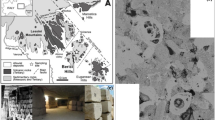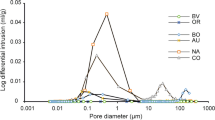Abstract
This paper describes the details of a laboratory investigation aimed at ascertaining the effect of penetrating surface treatments on the micro-porosity and water transport properties of three building stones used in the construction of historic buildings and monuments within Europe. The pore-structure and morphology of treated and untreated stone specimens were assessed using a combination of helium autopycnometry, mercury intrusion porosimetry and scanning electron microscopy techniques. Water repellence and transport properties were evaluated using the Karsten tube and magnetic resonance imaging techniques respectively.
It was found that surface penetrating treatments have a pore-refining effect on the stone matrix, the extent of internal alteration being dependent on the initial porestructure. A treatment efficiency index has been established for evaluating the performance of treated surfaces.
Résumé
Cet article présente d’une manière détaillée une étude en laboratoire avec pour objectif d’identifier l’effet de traitements de surfaces sur la micro-porosité et les propriétés de transport de l’eau de trois principales sortes de pierre de construction utilisées dans la réalisation d’édifices historiques et de monuments en Europe.
La structure des pores et la morphologie d’échantillons de pierre traitées et non-traitées ont été évaluées au moyen d’une combinaison d’hélium auto-pycnométrie, de porosimétrie de mercure et de techniques de microscopie par balayage d’électrons. Les propriétés de transport-hydrophobiques ont été évaluées en utilisant la méthode du tube Karsten et la technique de l’image de résonance magnétique.
Les résultats de l’étude ont montré que les traitements aux surface pénétrantes ont un effet de raffinement des pores sur la matrice de la pierre mais que la mesure de changement intérieur dépend de la structure initiale des pores. Un index d’efficacité de traitement a été établi pour l’évaluation de la performance des surface traitées.
Similar content being viewed by others
References
Wendler, E., ‘Treatment of Porous Building Material with Water Repellent Agents-Risk or Protection’ in ‘Surface Treatment of Building Materials with Water Repellent Agents’, Proceedings 1st International Symposium, Delft, 1995 (University of Delft, 1995) 25-1/25-10.
Perez, J. L., Villegas, J. F., Vale, M. A., Bello, M. A. and Alcalde, M., ‘Effect of consolidant and water repellent treatments on the porosity and pore-size distribution of limestone’ in ‘Methods of evaluating products for the conservation of porous building materials in monuments’, Proceedings of the International Colloquium, Rome 1995, 203–211.
Garcia, N., Sanchez De Rojas, M. I. and Frias, M., ‘Study of porosity and physical properties as methods to establish the effectiveness of treatments used in two different Spanish stones: Limestone and sandstone’ in ‘Methods of evaluating products for the conservation of porous building materials in monuments’, Proceedings of the International Colloquium, Rome 1995, 147–160.
Schwamborn, B., ‘Retreatment of Natural Stone Faces’, in Proceedings, 4th International Colloquium on ‘Material Science and Restoration’, Vol. 1, (Wittmann, F., Gerdes, A. (editors.)), Freiburg, Aedificatio, 1996, 633–647 (only available in German).
McDonald, P. J., Pritchard, T. and Roberts, S. P., ‘Diffusion of water at low saturation levels into sandstone rock plugs measured by broad line magnetic resonance profiling’,J. Colloid and Interface Science 177 (1996) 439–440.
Bohris, A. J., McDonald, P. J. and Mulheron, M., ‘The visualisation of water transport through hydrophobic polymer coatings applied to building sandstones by broad-line magnetic resonance imaging’,Journal of Materials Science 31 (22) (1996) 5859–5864.
Benson, T. B., McDonald, P. J., Mulheron, M. and Nwaubani, S. O., ‘The use of magnetic resonance imaging techniques in assessing the uptake of surface treatments and water movement through stone faces’Mater. Struct. 31 (1998) 423–427.
Bohris, A. J., Mcdonald, P. J., Mulheron, M. J., Newling., B. and Le Page, B., ‘A Broad Line Magnetic Resonance Imaging Study of Water Transport in Cementitious Building Materials’ in ‘Spatially resolved magnetic resonance: Methods and applications to Materials Science, Agriculture and Medicine’, Proceedings of 4th International Conference on Magnetic Resonance Microscopy and Macroscopy, Albuquerque, New Mexico, Sept. 1997 (Wiley-VCH, 1998) 273–280.
European Commission: ‘Re-treatment of Consolidated Stone Faces’ EC Contract EV5V-CT94-0518, Final Report, Vol. II, ‘Laboratory and Site Tests’, Brussels, 1996.
Tilly, G. P., Nwaubani, S. O., Sasse, H. R. and Bordado, J., ‘Re-treatment and Assessment of Consolidated Stone Faces’, EC Sponsored Research Project Seminar, Treiste, 1996.
Nwaubani, S. O. and Dumbelton. J. ‘Influence of Polymeric Surface treatments on the permeability and microstructure of High Strength Concrete’ in ‘Polymers in Concrete’, 3rd Southern African Conference and ICPIC Workshop, Johannesburg, July 1997, 388–402.
Author information
Authors and Affiliations
Rights and permissions
About this article
Cite this article
Nwaubani, S.O., Mulheron, M., Tilly, G.P. et al. Pore-structure and water transport properties of surfacetreated building stones. Mat. Struct. 33, 198–206 (2000). https://doi.org/10.1007/BF02479415
Received:
Accepted:
Issue Date:
DOI: https://doi.org/10.1007/BF02479415




